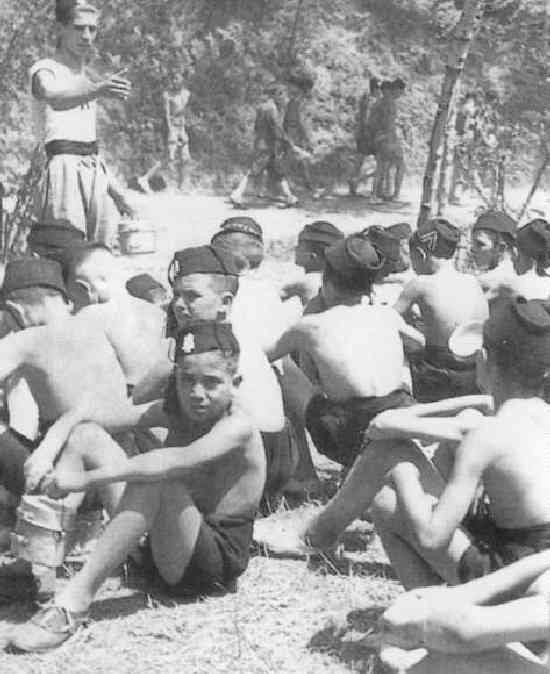
Italian Fascist Youth Group: Activities

Figure 1.-- Certainly available photographs suggest that the organization placed great emphasis on drill and inspection. Many images show the boys lined up or marching in uniforms. We also see them participating in parades, although we rarely know what the occassion was. We also note sport and athletic activities in what looks to be a summer camp environment.
|
|
Children and youth in Fascist Italy were raised with religious,
military, para-military and academic training. Children were expected to be off the street and persuing their studies. School was conducted 6 days a week and there was religious and para-military training on the weekends. The children were taught to respect God, country, King and Queen, Il Duce, his parents, and all authority, especially the police. We have very limited information on Balilla activities at this time. Certainly available photographs suggest that the organization placed great emphasis on drill and inspection. Many images show the boys lined up or marching in uniforms. We also see them participating in parades, although we rarely know what the occassion was. We also note sport and athletic activities in what looks to be a summer camp environment. Para-military traing was also coducted at camps. These camps were held dyring tghe summer and school vacations. At this point our assessment of Balilla activities is entirely based on available photographs. We have been unable to find any literature yet describing Balilla activities. As the organization included boys through age 18, there must have been a wide range of activities based on the different ages. Para-military training was an important part of the program. There were also activities associated with the different specialized sections.
Drill and Inspection
Certainly available photographs suggest that the organization placed great emphasis on drill and inspection. Adult recall the drill and inspections as well as the rifels. We note an interview of a Bailla member. RS: "As a child what were your first memories of Mussolini; did you ever see him or anything?" LP: Well we used to go to school… ah, no, I didn’t see him personally, but we have to obey all his rules. We used to… like here we have the Boy Scouts, in Italy we have the Bailla, we used to call…. The kids from the… when you go to grammar school right away they give the little uniform and every Saturday we used to go to the gym, we used to do a lot of things. It was Bailla we used to call it, yeah." RS: "And Mussolini started that?" LP: "Yeah. Matter of fact, I was eleven years old and knew how to maneuver the musketto we used to call it, the gun. Used to call nine- I think they used to call it the ninety-one, mother ninety-one gun. They used to teach us how to use that." [Pagano]
Para-military traing was also coducted at camps. Para-military training was an important part of the program. We note younger children handling replica rigles and learning to load them. We do not have information at this time on the para-military activities of older boys. What ever the nature of the training, it seems to have had little impact on the martial spirit of Italian soldiers in World war II. This contrasts sharply with the impact of Hitler Youth training.
Open Air Activities
The Balilla encouraged open air activities and exposing children to sunshine. Usually on Saturday Balilla had their drill in the open air. There were also open air activities at Balilla both summer camps and day camps.
Parading
Many images show the boys lined up or marching in uniforms. We also see them participating in parades, although we rarely know what the occassion was.
Sport
We also note sport and athletic activities in what looks to be a summer camp environment.
The Balilla set up many summer camps. Quite a number od sleep-away were located at seaside sites with beaches. For children that didn't go the summer camps, the Balilla organized village and town summer day camps--"campo solare" (sunshine camp). The children spent the day together in open air wearing light clothing. Most had uniforms, but not their Balilla uniforms. They usually white rompers or shorts and caps. There seems to have been uniforms adopted locally rther than nation-wide. I don't have a lot of information about activities at the camps or just how popular they were with the children who attended. The camps were free, but i don't think that they were compulsory.
Sources
Pagano, Leone, "Interview by Rosanne Sheridan," Voices for the World War II Project, Center for Oral History, University of Connecticut (April 19, 2001).
HBU

Navigate the Historic Boys' Uniform Web Site:
[Activities]
[Biographies]
[Chronologies]
[Countries]
[Essays]
[Garments]
[Organizations]
[Religion]
[Other]
[Introduction]
[Bibliographies]
[Contributions]
[FAQs]
[Questions]
[Unknown images]
[Boys' Uniform Home]
Navigate the Historic Boys' Uniform Web organizatiion pages:
[Return to the Main Italian Fascist youth page]
[Boys' Brigade]
[Camp Fire]
[Hitler Youth]
[National]
[Pioneers]
[Royal Rangers]
[Scout]
Created: January 28, 2004
Last updated: 9:27 PM 1/23/2014



